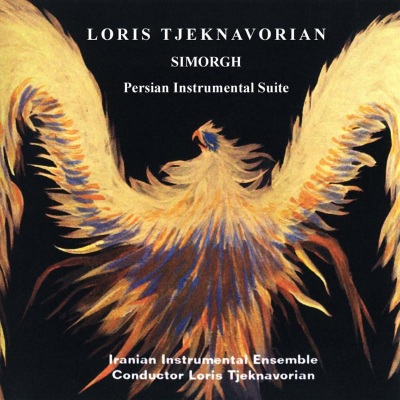
"Simorgh" Dance Drama for Iranian Instrumental ensemble (Persian Instrumental Suite)
Simorgh Dance Drama for Iranian National Instruments (Ney, Santoor, Gheychak, Kamancheh, Tar, Oud, Robab, Tombak, Naghareh, Fars, Gavargeh, Dohol), and Piccolo, Flute, Timpani, Tom-tom, and Cymbals. Composed in 1973, Tjeknavorian’s twelve-movement Dance Drama was commissioned by choreographer Robet de Warren (Head of Iranian Folklore Dance Ensemble), who himself choreographed the work in the same year, in Tehran. A year later, the ballet was produced by the London Festival Ballet, choreographed by Andre Prokovsky, featuring prima-ballerina Galina Samsova of the Saint Petersburg Ballet. The ballet was recorded by Faramarz Payvar’s Iranian National Instrumental Ensemble in 1973. The story behind this Dance Drama was taken from a number of Persian love stories. Pari and Ahriman were the first man and women created in this world. Ahriman falls in love with Pari and wants to make love to her. In a struggle Pari dies. Ahriman turns into an incarnation of evil (the destroyer of love), and makes repeated attempts to crush and destroy love everywhere possible. For instance, one of the stories is about the love between a nightingale and a rose. When Ahriman learns about it, he gives thorns to the rose to hurt the nightingale when they embrace. Another episode is the love between the butterfly and the flame. Ahriman blinds the butterfly in order to burn him. Ahriman eventually manages to destroy all the love in the world, setting the earth on fire. The epilogue is based on the Iranian poet Atar’s “Conference of the Birds” where millions of birds, envious that humans have a God and they don’t, fly far away on a quest to find their own divinity. Only thirty of those make it to the chamber of God and, once entering it, they find that God (Simorgh) is in themselves. Persian Instrumental suite After graduating from the Vienna Music Academy in composition in 1961 Tjeknavorian was appointed as the head of the Iranian musical archive at the Iranian Ministry of Culture. During that time, Tjeknavorian extensively researched native Iranian musical instruments and styles. Tjeknavorian was aiming to create polyphonic music for the the Iranian instrumental ensembles - something in contrast with the usual practice of playing in unison. For several years Tjeknavorian experimented with this approach, composing documentary and feature film scores (Bita, Tangsir, Tajavoz, etc.) for Iranian instruments in polyphonic style. In 1972 he composed the dance drama "Simorgh" and orchestrated one of the versions of his opera "Rostam & Sohrab" for the Iranian Instrumental ensemble. Tjeknavorian worked closely with Faramarz Payvar and his ensemble. The major performers among them were Faramarz Payvar (Santoor), Hushang Zarif (Tar), Mohammad Esmaily, Zarb (percussion) Hasan Nahid (Ney), Rahmatollah Badii, and Kamanche-Gheychak. "Simorgh" is the first historically polyphonic orchestration for Iranian instruments.
